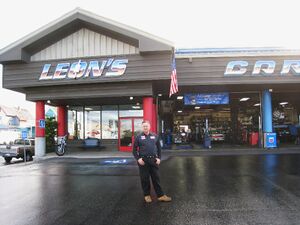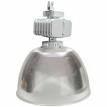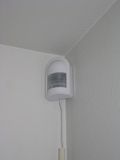
(Photo by Charles Swanson)
In June 2008 the Redwood Coast Energy Authority (RCEA) completed a lighting retrofit for Leon's Car Care Center to increase energy efficiency.
Redwood Coast Energy Authority (RCEA)[edit | edit source]
The RCEA is a Joint Powers Authority commissioned by seven local municipalities under contract with Pacific Gas and Electric (PG&E) company to promote regional energy efficiency.[1] The organization is funded through taxes collected by PG&E and the California Public Utilities Commission. The RCEA also operates under a smaller contract with the US Department of Energy to promote solar energy use.[2]
The Redwood Coast Energy Watch is a $1.6 million partnership program between the RCEA and PG&E. Funded by the California Public Utilities Commission, Public Goods Charge, the Redwood Coast Energy Watch is responsible for the energy efficiency upgrades at Leon's Car Care Center and other area businesses.
Leon's Electrical Demand[edit | edit source]
Leon's Car Care Center (Figure 1) is a family owned and operated business that has been in Eureka, California for over 48 years. Since 1992, Leon's Car Care Center has been located in a steel I-beam shop with an attached wood frame office, built new to their specifications. The building was designed to decrease reliance on electric light by utilizing windows in the upper reaches of the structure, allowing natural light to penetrate to the main shop area. Lighting accounts for 20% to 50% of the energy consumed by a commercial building.[3] Automotive repair requires the use of power tools and computerized diagnostic equipment in addition to sufficient lighting. Power tools consume more operational current than lights, but are used sporadically, while lights are on continuously. The shop is also equipped with eight vehicle lifts and two air compressors that run most of the power tools.
The shop was originally illuminated using 32 400 watt High Intensity Discharge (HID) metal halide lamps (Figure 2).[4] The metal halides were supplemented with wall mounted fluorescents for workbench lighting. The office contains computers, fluorescent lighting, two climate control units, one cold soft drink vending machine, and a snack vending machine.

Metal Halide fixtures replaced by Leon's.
Retrofit Hardware[edit | edit source]
Fluorescent Lighting[edit | edit source]
New Fluorescent Lamp Ballast Energy Conservation Standards (10 CFR, Part 430) were set in 2000 by the US Department of Energy, establishing a new minimum Ballast Efficacy Factor. These new standards effectively discontinued production and sale of the ballasts used in conjunction with T12 lamps by 2005.[5] The 40 watt T12 lamp ballasts were replaced by 36 watt T8 lamp ballasts, producing the same amount of light while using less electricity.[6] The T8 electronic lamp ballasts, installed by the RCEA, and certified by the National Electrical Manufacturers Association, reduced consumption by an additional two to five watts.[7] Older magnetic ballasted fixtures have a noticeable flicker that can reduce efficiency of the lamp by up to ten percent.[8]
All of the existing two lamp fluorescent fixtures in the shop and office (Figure 4) were replaced by the RCEA during the first phase of the retrofit. Thirty-one electronic and nine magnetic T12 ballasted fixtures were replaced with T8 ballasted fixtures at this time. During the final phase of the retrofit, Leon's replaced 32 400 watt HID metal halide lamps (Figure 2)[9] with six-lamp T8 ballasted fluorescent fixtures (Figure 3).[10] Metal halide lamp fixtures can cost 50% more[11] to operate than the T8 electronically ballasted fluorescent fixtures.
-
thumbFigure 3.
Six lamp T8 fixtures used to replace metal halides. -
Figure 4.
New two lamp T8 fixtures used in office.(Photo by Charles Swanson)
Energy Miser[edit | edit source]
The RCEA has overseen the installation of an energy miser (Figure 5) on the snack and cold drink vending machines in the office. The miser acts as a motion sensor in conjunction with a timer that shuts the appliances down after a period of inactivity. According to Austin, Texas based utility company Austin Energy, an energy miser has the potential to reduce the energy consumption of cold drink and snack vending machines by 40% and 80% respectively.

Vending machine Energy Miser.
(Photo by Charles Swanson)
Data Analysis[edit | edit source]
Results[edit | edit source]
After the RCEA retrofit, electrical consumption dropped an average of 252 kWh per month. This value exceeded the RCEA predicted savings of 4.2 percent. Cost savings and CO2 emissions reductions have been calculated using the same monthly kWh value.
Electrical consumption over a three year period was graphed (Figure 6) and labeled to indicate when the RCEA retrofits occured. Another graph (Figure 7) compares electrical data before and after the retrofit. The ten-month periods of June 2008 to March 2009, and June 2007 to March 2008 are used as comparison periods before and after the retrofit (Figure 7). The sample time period was limited, due to the fact that ten months after the retrofit, Leon's performed their own lighting retrofit. The monthly averages are projected to one year for comparison to the RCEA yearly values.
-
Figure 6. Leon's three year monthly kWh consumption data.
-
Figure 7. Pre and post retrofit electrical consumption.
Table 2: Projected vs. actual values[12]
| Projected | Actual | |
|---|---|---|
| Yearly Cost Savings | $389.20 | $504.28 |
| Monthly Cost Savings | $32.43 | $42.02 |
| Yearly kWh Reduction | 2,334 kWh | 3,024 kWh |
| Yearly CO2 Reduction | 1,213 lbs | 1,585 lbs |
| Simple Payback | 3.6 years | 2.8 years |
Carbon Dioxide (CO2) Emissions[edit | edit source]
The RCEA retrofit reduced carbon dioxide emissions at Leon's by 1,585 pounds per year. Kilowatt hours (kWh) can be equated to pounds of CO2 emitted in relation to the various processes involved in the production of the electricity. Humboldt County's electricity comes from a number of sources (Figure 9).[13] Pounds of CO2 produced per kWh varies from source to source, e.g. electricity generated from burning coal produces an estimated 2.25 pounds per kWh,[13] all of this is associated with the actual emissions coming from the combustion. PG&E reports that it generates 0.524 pounds of CO2 per kWh produced. The kWh consumption by Leon's Car Care has been converted to pounds of CO2 in Figure 8.[14]
-
Figure 8. Comparing CO2 emissions equivalents before and after the lighting retrofit.
-
Figure 9. Humboldt County's electrical energy source distribution.
Future Retrofits[edit | edit source]
Leon's is considering replacing one of their two piston-run air compressors with a Rotary Air Compressor. This would decrease energy consumption in addition to decreasing shop noise and improving air pressure consistency among the pneumatic tools. The air compressors are the main source of energy for the power lifts used in the shop to raise vehicles for service and are run almost constantly.
General Manager Dale Warmuth is conscious of the impact that energy use has on his business. He is delighted at the savings his company sees in their efforts to improve efficiency both financially and ecologically. Mr. Warmuth has seen a 33% decrease in consumption since the retrofits including replacement of the metal halides. He is satisfied with the level of service received from the RCEA, and continues to pursue new and more efficient practices.
Related Links[edit | edit source]
https://www.energy.ca.gov/ - The California Energy Commission (CEC) sets California state standards on appliance and building energy efficiency. The CEC also promotes public awareness through research and demonstration for public interest.
http://www.aboutlightingcontrols.org/index.shtml - Lighting Controls Association (LCA) is an information resource for the professional building industry to promote knowledge of high quality energy efficient lighting products.
http://www.eere.energy.gov/ - The US Department of Energy (DOE) Energy Efficiency and Renewable Energy site with national industry information including solar, wind, hydrogen fuel cell and geothermal.
http://www.eia.doe.gov/index.html - The US Energy Information Administration (EIA) site for official energy statistics.
References[edit | edit source]
- ↑ Redwood Coast Energy Authority. About RCEA: Governance. Accessed online November, 2009. http://web.archive.org/web/20080317073211/http://www.redwoodenergy.org:80/ContentPage.asp?ContentID=92
- ↑ U.S. Department of Energy. Energy Sources: Solar. Accessed online November, 2009. http://www.energy.gov/energysources/solar.htm
- ↑ Energy consumption.(n.d.) In Wikipedia. Retrieved November, 2009. http://en.wikipedia.org/wiki/Lighting#Energy_consumption
- ↑ Farmtek. ValuTek 400W Metal Halide Bay Light. Retrieved November, 2009. Permission pending. http://www.farmtek.com/farm/supplies/prod1%3Bft1_lighting_fixtures_bulbs-ft1_metal_halide_bay_fixtures%3Bpg105713.html
- ↑ DiLouie,Craig.(2005, November) Energy Policy Act of 2005 sets New Ballast Efficiency Standards. Retrieved November, 2009 from Lighting Controls Association website. http://web.archive.org/web/20100308065952/http://www.aboutlightingcontrols.org:80/education/papers/ballast_law.shtml
- ↑ Phillips, Ian.(n.d.) Fluorescent Lamps and Ballasts. Retrieved November, 2009 from Fluorescent Lamps and Ballasts by Ian Phillips. http://web.archive.org/web/20130719000416/http://wood.bigelowsite.com/articles/fluorescent_lamps_and_ballasts.htm
- ↑ DiLouie,Craig.(May, 2008) NEMA Premium Brand Now Includes High-Efficiency Fluorescent Electronic Ballasts for 4-ft T8 Lamps. Retrieved December, 2009 from Lighting Controls Association website. http://www.aboutlightingcontrols.org/education/papers/2008_nemaballasts.shtml
- ↑ Fluorescent Lamp:Ballast.(n.d.) In Wikipedia. Retrieved December, 2009 http://en.wikipedia.org/wiki/Fluorescent_lamp#Ballast
- ↑ Farmtek. ValuTek 400W Metal Halide Bay Light. Retrieved November, 2009. http://www.farmtek.com/farm/supplies/prod1%3Bft1_lighting_fixtures_bulbs-ft1_metal_halide_bay_fixtures%3Bpg105713.html
- ↑ 6 Lamp Fixtures:Flat profile, 6 lamp, T8, fixture.(n.d.) Retrieved December, 2009 from FHB Lighting website http://www.fluorescent-high-bay.com/products/Flat-Profile%2C-6-Lamp%2C-T8%2C-Fixture.html
- ↑ DiLouie,Craig.(May, 2009) Fluorescent Retrofits for High/Low-Bay Applications. Retrieved December, 2009 from Lighting Controls Association website. http://www.aboutlightingcontrols.org/education/papers/high-low-bay.shtml
- ↑ Calculations based on average cost of $0.01667 per kWh and 09Com-600-SFL-170-CFL-60-CTR rebate
*Project Summary courtesy of RCEA Program Manager: Dana Boudreau, Auditor: Budd DickinsonfckLR - ↑ 13.0 13.1 U.S. Environmental Protection Agency.(2009, February 19) How clean is the electricity I use?-Power Profiler . Retrieved December, 2009. http://www.epa.gov/cleanenergy/energy-and-you/how-clean.html
- ↑ PG&E.(n.d.) Environment:Carbon Footprint Calculator Assumptions. Retrieved December, 2009. http://web.archive.org/web/20140719170048/http://www.pge.com/about/environment/calculator/assumptions.shtml




